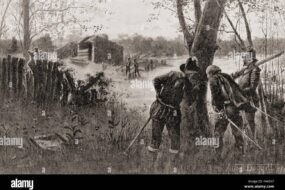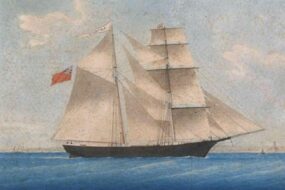
Teh Lost Colony of roanoke: The Mysterious Disappearance that Shaped American history
imagine stumbling upon an abandoned settlement, with no signs of struggle or violence, but with a single, cryptic clue left behind – a word carved into the bark of a tree. This is the enigma that has captivated historians and archaeologists for centuries – the mysterious disappearance of the Lost Colony of Roanoke. In 1590, a group of English settlers vanished into thin air, leaving behind only a few tantalizing hints as to thier fate. But what really happened to them, and why is their disappearance still shrouded in mystery? To understand the significance of this event, we need to go back to the late 16th century, when England was eager to establish a foothold in the New World. Sir Walter Raleigh, a renowned explorer and courtier to Queen Elizabeth I, had been granted a charter to settle a colony in north America.
In 1585, Raleigh sent an expedition to Roanoke Island, off the coast of what is now North Carolina, with a group of settlers, including men, women, and children.The colony was established, but it struggled to survive, and by 1586, the settlers were on the brink of collapse.When a supply ship arrived, they were rescued and returned to England. However, Raleigh was not deterred.He saw the potential for a successful colony and sent a second group of settlers to Roanoke in 1587. This time, the colony was led by John White, an artist and cartographer who had been part of the previous expedition. White’s group included 115 settlers, including his own family, and they arrived at Roanoke in July 1587. But the colony was struggling from the start. The settlers were not prepared for the harsh conditions they faced, and they struggled to build adequate shelter and find food. John White’s daughter, Eleanor Dare, gave birth to a baby girl, Virginia Dare, who became the first English child born in the New World. As the colony’s struggles continued, John White realized that he needed to return to England to secure more supplies and support. He left the colony in 1587, leaving behind his family and the other settlers. however, his return to England was delayed by the English naval war against Spain, and it wasn’t until 1590 that he was able to secure a ship and return to Roanoke. When he arrived, he was met with an eerie silence. The colony was abandoned, with no signs of struggle or violence. The only clue left behind was the word “CROATOAN” carved into the bark of a tree.the mystery of what happened to the Lost Colony of Roanoke has sparked intense debate and speculation over the centuries.some believe that the settlers were killed by Native American tribes, while others think that they may have been absorbed into the local Croatoan tribe. Others still believe that they may have tried to return to England and were lost at sea. The word “CROATOAN” has been interpreted in many ways, with some believing it was a clue left behind by the settlers, indicating that they had moved to the island of Croatoan, now known as Hatteras Island. Some of the possible explanations for the disappearance include:
Massacre by Native Americans: One theory is that the settlers were killed by Native American tribes, who may have seen them as a threat to their land and way of life.
Absorption into the Croatoan tribe: Another theory is that the settlers were absorbed into the local Croatoan tribe, and may have intermarried with the native population.* Loss at sea: Some believe that the settlers may have tried to return to England and were lost at sea, possibly due to a storm or other navigational error.
As the years passed, the legend of the Lost Colony of Roanoke grew, capturing the creativity of historians, archaeologists, and the general public. In the 19th century, a number of excavations were carried out on Roanoke Island, but no conclusive evidence was found to explain the disappearance of the settlers. In the 20th century,a number of theories emerged,including the possibility that the settlers had been victims of a hurricane or other natural disaster. Though, none of these theories have been proven conclusively.Despite the lack of a clear description, the disappearance of the Lost Colony of Roanoke has had a lasting impact on American history.
The story of the Lost colony has also become a powerful symbol of the challenges and risks faced by early European settlers in North America. In recent years, archaeologists have made a number of significant discoveries that have shed new light on the story of the Lost Colony. In 2012, a team of archaeologists from the University of Bristol discovered evidence of a fort on Roanoke Island, which they believe may have been built by the settlers. Other discoveries have included the remains of a number of 16th-century settlements, which have been found on the islands off the coast of North Carolina. The legacy of the Lost Colony of Roanoke continues to be felt today, inspiring countless works of art, literature, and music.
Some of the key figures involved in the Lost Colony of Roanoke include:
| Name | Role |
|---|---|
| Sir Walter Raleigh | Founder of the colony and granted a charter by Queen elizabeth I |
| John White | Artist, cartographer, and leader of the second group of settlers |
| Eleanor Dare | John White’s daughter and mother of Virginia Dare |
| Virginia Dare | The first English child born in the New World |
The story of the Lost colony of Roanoke is a testament to the enduring power of mystery and intrigue, and a reminder that even the most seemingly inexplicable events can have a profound impact on our understanding of the world.As we continue to explore the past, we are drawn into a world of fascinating stories, complex characters, and unexpected twists and turns.
#TheLostColonyOfRoanoke #MysteriousDisappearance #AmericanHistory #UnsolvedPhenomena #HistoricalMysteries #InfographicStory #WorldHistory #TrueStory #HistoryNerd #GlobalFigures #DidYouKnow #RoanokeIsland #NorthCarolina #EarlyAmericanSettlements #EuropeanExploration #ColonialAmerica #HistoryBuff #mysteryandintrigue








